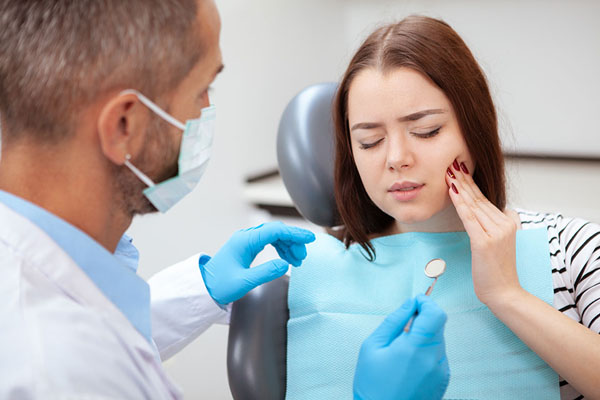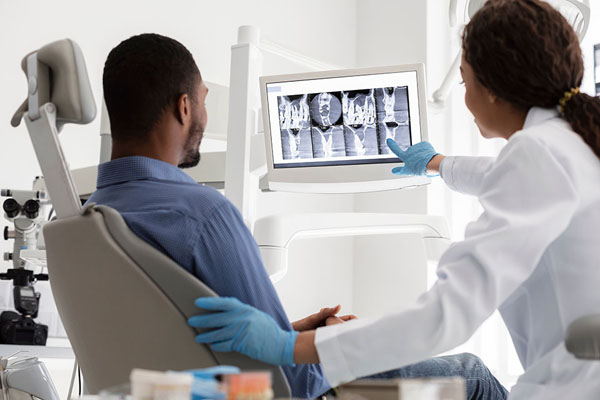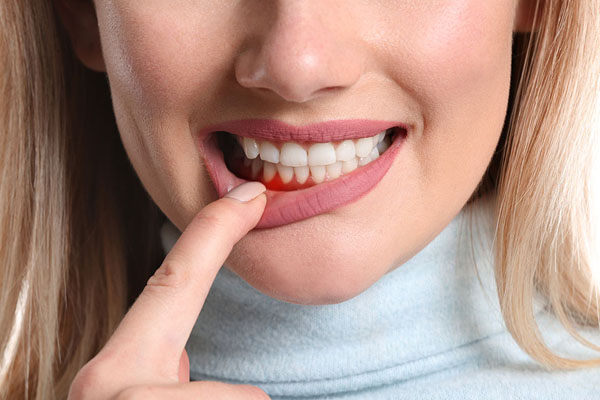Do You Have Gum Disease Symptoms?
Gum disease is one of the most common oral health conditions. But how do you know if you have gum disease or if you’re more likely to develop the condition? Our dentist discusses the gum disease risk factors and symptoms in our guide below.
If you’re experiencing any of the symptoms of gum disease mentioned, call our Sacramento dental office today at (916) 929-9222 for an appointment.
Symptoms of Gum Disease
Red, Tender, or Swollen Gums
Healthy gums should be firm and pale pink. If you notice that your gums are red, swollen, or tender, it may be a sign of gum disease.
- Redness: Healthy gums should be pink in color. If your gums appear red or have a reddish hue, it may indicate inflammation caused by gum disease. This redness is often a result of increased blood flow to the infected area.
- Tenderness: Healthy gums shouldn’t be tender or painful to touch. However, when you have periodontal disease, your gums can become sensitive and tender. You may experience discomfort while brushing, flossing, or eating certain foods.
- Swelling: Swollen gums are a common symptom of periodontal disease. When the gum tissues are infected, they can become puffy and swollen. This swelling can make your gums appear larger than usual and may even cause them to protrude between your teeth.
Bleeding Gums
Bleeding gums are one of the more common warning signs in the early stage of gum disease.
- Bleeding during brushing or flossing: Gums shouldn’t bleed when you brush or floss your teeth. If you notice blood on your toothbrush or dental floss, it could be a sign of gum disease. The bleeding is typically caused by the inflammation and infection in the gums.
- Spontaneous bleeding: In some cases, gums affected by gum disease may bleed spontaneously, even without any stimulation such as brushing or flossing. You may notice blood on your pillow in the morning or during normal activities like eating or talking.
- Persistent bleeding: Gum disease-related bleeding is often recurrent and doesn’t go away on its own. If your gums continue to bleed for an extended period, it’s essential to seek dental attention for proper diagnosis and treatment.
Receding Gums
Periodontal disease can cause the gums to pull away from the teeth, creating pockets where bacteria can accumulate.
- Gum line changes: As periodontal disease progresses, the gum tissue can start to recede or pull away from the teeth. This results in the exposure of the tooth roots, which can cause sensitivity and aesthetic concerns.
- Tooth sensitivity: When the gums recede, the underlying tooth roots become exposed. These roots aren’t protected by the enamel that covers the tooth crowns, making them sensitive to hot, cold, or sweet stimuli.
- Longer-looking teeth: As the gums recede, the tooth roots become more visible, making the teeth appear longer than before. This change in tooth length and the exposure of the roots can affect the aesthetics of your smile.
- Spaces or gaps between teeth: Receding gums can cause the teeth to appear spaced or have gaps between them. The loss of gum tissue can lead to a change in the alignment and positioning of the teeth.
- Loose Teeth: In severe cases of gum disease, the supporting structures of the teeth, including the gums and the underlying bone, can become weakened. This can result in loose teeth or tooth mobility issues.
Bad Breath
Bad breath, also known as halitosis, may also indicate the progression of periodontal disease.
- Bacterial buildup: Periodontal disease is caused by the accumulation of plaque, a sticky film of bacteria, on the teeth and gums. As the bacteria multiply and thrive in the mouth, they release volatile sulfur compounds (VSCs) that have a distinctly unpleasant odor.
- Gum infection: The bacteria in the plaque can cause an infection in the gum tissues, leading to inflammation and damage. This infection can create an environment where the bacteria continue to produce foul-smelling gasses.
- Poor oral hygiene: Inadequate oral hygiene practices can worsen periodontal disease and contribute to bad breath. When plaque and food particles aren’t effectively removed from the mouth through brushing and flossing, they can decompose and provide a breeding ground for bacteria, leading to persistent bad breath.
Loose or shifting teeth
Periodontal disease can cause the bone that supports your teeth to deteriorate, which can lead to loose or shifting teeth.
- Gum detachment: As periodontal disease worsens, the infection and inflammation can cause the gum tissue to detach from the teeth. This leads to the formation of pockets or spaces between the gums and the teeth. The loss of gum attachment weakens the support for the teeth, making them feel loose or mobile.
- Bone loss: The bacteria responsible for gum disease can also attack and destroy the underlying bone that supports the teeth. This condition is known as periodontitis. As the bone is gradually lost, there’s less support for the teeth, which can result in them becoming loose or shifting position.
- Changes in bite alignment: As the teeth lose support and become mobile, they can start to shift or move out of their normal alignment. This can affect your bite, causing changes in how your upper and lower teeth fit together when you close your mouth.
- Tooth loss: If periodontal disease is left untreated and progresses to an advanced stage, the teeth may become so loose that they eventually fall out or require extraction due to the lack of support from the surrounding structures.
Changes in Your Bite
Gum disease can also cause changes in your bite, which is the way your teeth come together when you close your mouth.
- Tooth mobility: As the disease progresses, it can cause the supporting structures of the teeth, including the gums and bone, to weaken. This can result in tooth mobility or looseness.
- Shifting teeth: Periodontal disease can cause the gums to recede and the bone to deteriorate, leading to changes in tooth positioning. As the teeth shift or move, the way your upper and lower teeth come together when you bite or chew can be altered. This can result in an irregular or misaligned bite.
- Malocclusion: Malocclusion refers to an improper alignment of the teeth when the jaws are closed. It can occur due to changes in tooth positioning caused by periodontal disease. As the teeth shift or become mobile, your bite may not fit together correctly, leading to malocclusion.
- Tooth wear: Periodontal disease can lead to changes in the way your teeth come into contact with each other during biting and chewing. This can cause uneven wear on the teeth, with some teeth experiencing excessive pressure or grinding against each other. Over time, this can lead to tooth wear, chips, or fractures, further contributing to changes in your bite.
Pus Between the Teeth and Gums
In advanced periodontal disease cases, you may notice pus between the teeth and gums.
- Gum abscess formation: When periodontal disease progresses, pockets or spaces can form between the teeth and gums due to the detachment of the gum tissue. These pockets create a favorable environment for bacteria to thrive and multiply. If the infection becomes localized and trapped within these pockets, it can lead to the formation of a gum abscess.
- Accumulation of pus: A gum abscess is characterized by the accumulation of pus, which is a thick, yellowish, or whitish fluid that consists of dead bacteria, inflammatory cells, and tissue debris. Pus is a sign of an active infection, and its presence indicates the presence of bacteria and the body’s immune response to combat the infection.
- Foul taste or odor: Pus from a gum abscess can sometimes lead to a foul taste or odor in the mouth. This unpleasant taste or smell is a result of the bacteria and their byproducts present in the pus.
Gum Disease Risk Factors
Several risk factors can increase the likelihood of developing gum disease, including:
- Poor Oral Hygiene: Failing to brush your teeth and floss regularly can lead to the buildup of plaque and tartar. Plaque and tartar accumulation can lead to tooth decay, periodontal disease, and other health conditions.
- Tobacco use: Smoking or chewing tobacco can significantly increase the risk of gum disease. These habits cause a decrease in the blood flow to the gums, making it harder for the body to fight off infection.
- Genetics: Some individuals may be more susceptible to gum disease due to genetic factors.
- Age: Older adults are more likely to develop gum disease, especially if they have poor oral hygiene habits.
- Diabetes: Individuals with diabetes are at a higher risk of developing gum disease due to their compromised immune system and increased susceptibility to infections.
- Medications: Certain medications, such as antidepressants and heart medications, can cause dry mouth, increasing the risk of periodontal disease.
- Hormonal Changes: Women are more likely to develop gum disease during pregnancy or menopause due to hormonal fluctuations. Morning sickness can also damage the integrity of your oral health.
- Poor Nutrition: A diet high in sugar and carbohydrates can increase the risk of gum disease as it promotes the growth of harmful bacteria in the mouth.
Frequently Asked Questions
Can gum disease be reversed?
In its early stages, gum disease can often be reversed through improved oral hygiene, such as brushing your teeth twice a day and flossing regularly, along with professional dental cleanings. However, if the disease has progressed to advanced stages, it may require more extensive treatment.
How can I prevent gum disease?
The best way to prevent gum disease is to practice good oral hygiene habits, including:
- Brushing your teeth twice a day and using fluoride toothpaste
- Flossing daily
- Visiting your dentist for regular dental check-ups and cleanings.
- Avoiding tobacco products
- Maintaining a healthy diet
How can dentists treat gum disease?
The treatment for gum disease will depend on the severity of the condition. In mild cases, improved oral hygiene and regular dental cleanings may be enough. However, more advanced cases may require scaling and root planing (a deep cleaning procedure), antibiotics, or even surgery.
Take Control of Your Oral Health Today
At our dental practice in Sacramento, we offer gum disease treatment to restore your dental health and preserve your smile’s appearance. If you’re experiencing symptoms of gum disease, don’t wait until the disease progresses.
Call us today at (916) 929-9222 to schedule your appointment. We’re committed to providing our patients with high-quality, compassionate dental care, and we look forward to helping you achieve a healthy, beautiful smile.



